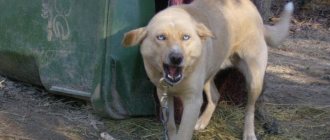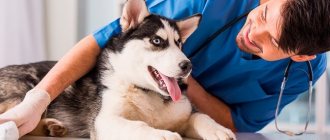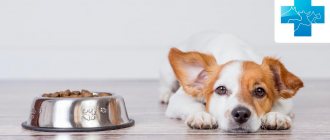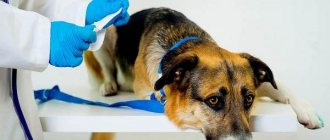“If we talk about male dogs, then their indications for castration are aggressive behavior towards people, towards other animals (manifestation of intraspecific aggression), marking territory in the apartment, vagrancy and running away from home. However, as for unclean behavior, then, in my experience and in the experience of my colleagues, dogs of small decorative breeds, including Jack Russell terriers and Jagd terriers, if they mark the territory in the apartment, then castration alone will not help,” noted expert.
The veterinarian recommends castration only as one of the methods of combating unclean behavior.
“If we write down a protocol, it includes training and behavior correction, including with the involvement of behavioral medicine doctors, and physical activity for the animal,” the veterinarian explained. Alexandra Alexandrova noted that, as a rule, from the entire list of recommendations, owners implement one or two points, and the most popular is castration.
“Everyone is waiting for a magic pill that will fix the animal,” the veterinarian added and emphasized that only through an integrated approach will it be possible to cope with territory marking.
“As for reducing vagrancy after castration, there is no consensus on this issue,” added Alexandra Alexandrova.
In addition, she noted that in males on a leash after castration, aggression towards other males whom they meet on the street on a leash may increase, even if they were previously indifferent to this or entered into social contact with them.
“Females after sterilization also tend to show aggression, but this time towards members of their family. But only if they were operated on before a year and these signs of aggression have already appeared,” the expert noted, citing a study by foreign veterinarians, adding that, according to another foreign study, aggression is not observed in females at all.
Any owner familiar with the problem of a dog marking at home
, knows how much headache these streams of urine left on the floor, walls, and furniture bring. First of all, the tags smell bad. Secondly, those surfaces that have been damaged by the dog’s dirty tricks have to be thoroughly washed regularly. Thirdly, it’s a shame that your tailed friend behaves, to put it mildly, so indecently on the territory of the house. In this article we will try to figure out what the causes of dog marks are, and we will also find out how to deal with them.
When does a dog pee and when exactly does it mark?
Before you decide how to wean your dog from marking in an apartment, you should find out what is meant by these same marks:
- Tags
are the application of unique odorous marks to certain objects.
Most often, in an apartment, the dog marks corners, the front door, and shelves with outdoor shoes. But there are also such pranksters who do not hesitate to pour urine on chairs, sofas, and the master’s bed. When planning to do a dirty trick, the dog sniffs for a long time the surface on which it plans to urinate; it is not in a hurry, but as if choosing where exactly to pee. Marks are always applied by the dog consciously, with some clear purpose
:
- To prove to all the pets in the house, and often to the owner himself, that I am in charge here.
By marking the territory, the dog seems to want to make it clear that everything around is its property;
Both males and females often mark their territory during the heat period.
, calling an individual of the opposite sex;
A dog may mark territory due to resentment towards its owner.
For example, the owner yelled at the pet for something. And the animal simply took revenge for the insult;
- It happens that a dog marks in an apartment, protecting its home from strangers.
As soon as one of the strangers (neighbors, family friends, postman, etc.) comes to visit, the dog begins to mark; - Very little puppies don't tag
up to 5 (maximum 6-7) months of age. They do not mark, but simply pee here and there due to weak bladder muscles;Involuntary emptying of the bladder cannot be considered a sign either.
- urinary incontinence. This problem is inherent in animals suffering from stress or any disease (cystitis, renal failure, polydipsia due to diabetes mellitus or pyometra, damage to the lumbar spine, etc.);
- When a dog pees at home due to prolonged abstinence, it cannot be considered a mark.
Many owners walk their pets for only 5-10 minutes, and some even forget to take their dog outside in a hurry so as not to be late for work. The animal endures and endures, and then simply pees anywhere, without waiting for the owner to take him outside.
Possible reasons
The objects of their marks, as a rule, are entrance doors, corners, small objects that stand separately in apartments, etc. As for the street, these can be trees, bushes, pillars, curbs surrounding the assigned territory, or car wheels , which have recently filled the courtyards near multi-storey buildings.
This behavior in dogs begins when they reach puberty, and it can be very difficult to wean your pet from this instinct, but it is possible if you show understanding of what is happening and perseverance in this matter.
Naturally, punishing a dog for such behavior will not achieve anything. The owner must show dissatisfaction with this act of his, emphasize with all his appearance that he is behaving badly, but in no case punish him. But it will be useful to observe your pet and understand why he behaves this way. Moreover, there are not so many reasons for such an act of an animal:
How to deal with dog marks
How to wean a dog from marking at home, and what measures can be taken, we will consider below:
- Castration
(removal of the testes in males and the ovaries and uterus in females) is the most effective method to prevent a dog from marking in the house. It happens that a castrated dog also marks quickly after surgery, but approximately 2-4 months after surgery, the animal’s hormonal background changes, and as a result, the desire to dominate or attract individuals of the other sex disappears. True, castration is appropriate only when there is no desire to continue the pet’s family;
If at least six months have passed since the operation, but the dog marks after castration as before, educational measures cannot be avoided. First , you should show the animal your dissatisfaction by pointing to a fresh mark
, and then say loudly and condemningly: “Ugh! Unscrupulous!" (“You can’t! Bad boy!”, etc.). Then the naughty dog must be sent to its rightful place (on the bed), ignoring the dog’s glances and whines for some time;
Some owners whose dog begins to mark resort to physical punishment (beating, spanking). Under no circumstances should you hit a dog in a tagging situation!
This will only embitter the animal, but will not rehabilitate it (surely the dog will continue to mark while the owner is not at home);
Often long (preferably at least 40-60 minutes, twice a day) active walks on the street
. Not just walking, but jogging, overcoming obstacles, catching a stick or ball. When exhausted, the dog may not do stupid things;
usually don't mark where they eat.
. You can place bowls of water and food in the most favorite places where your pet urinates;
To isolate the dog away from those places in the apartment where it is accustomed to marking, you can try to build some kind of barrier
so that the animal is in a confined space and not wandering around the house (for a small breed dog this could be a simple box of household appliances, for a large dog you will need something more substantial, for example, a mini-pen made of iron rods);
As a rule, dogs that are accustomed to marking in an apartment have their own especially favorite places (for example, the floor in the corner of the room). The “X” area should be thoroughly washed each time, applying a little citrus oil or a mixture of tobacco and aromatic red pepper to the problem area
(these smells are unpleasant for the dog). But the use of ammonia, chlorine and acetic acid should be abandoned, since the mentioned substances are destructive to the animal’s sense of smell;
What to do if a dog marks after being offended by the owner? Of course, the owner should establish a relationship with the pet
. You need to give the animal maximum attention (games, affection, conversations);
Some owners make their own or purchase panties or a belt for dogs so that they don’t get marked.
. These unique diapers absorb urine and turn it into gel. But you will have to change special inserts in your belt or panties often - up to 5-6 times a day (and sometimes more often). It will not work to put a diaper on your dog in the morning and take it off only late in the evening, since constantly wearing such a hygiene product is fraught with the development of dermatitis and other skin problems;
Methods of influence
It has already been said above that punishing a dog for marking him, much less shouting at him, poking him with his nose and hitting him, is useless and unreasonable. This will not bring a positive result, but will only negatively affect trust. Needs toilet training.
But one should express a negative attitude towards his action. Show him your dissatisfaction. When your pet approaches you, ignore him and turn away. You can shame him with words like “Ugh, that smells bad”, “Naughty dog, what have you done!” Then send him to his place, turning away and making it clear that you are unhappy with his action. But here it should be noted that this method will be effective against smart and conscientious pets. Since this act is nothing more than an instinct, the problem of why a dog marks in an apartment can be resolved in several stages.
Will castration help?
It is not as easy as it seems at first glance to wean a pet from such a habit. For this reason, many experts advise resorting to castration. This is also due to the fact that the root cause of such an instinct is sexual desire.
Therefore, it is believed that when the question arises of how to wean a male dog from marking at home, and this is associated with hormonal surges, castration of the animal is considered the simplest, most effective and safest method. And not only the male dog whose testes are removed, but also the female dog (after all, as stated at the beginning of the material, they also suffer from this defect) - an operation is performed to remove the uterus and ovaries.
It is believed that after surgery the owner will no longer have to think about how to get rid of such a problem. Over time, the pet’s hormonal background will fall into place and this canine vice will no longer bother you.
Although this approach also has its “buts”. Some sources stipulate that castration is not a panacea for this instinct of your tailed friend. The operation reduces the desire to mark in more than 80 percent of male dogs, but completely eliminates the problem in only 40 percent. So whether or not to resort to this method in the absence of a 100% guarantee is up to the animal owner to decide.
Medical indications: 3 situations when castration is necessary
There is nothing unnecessary in the body - the main argument of opponents of castration. This is true. The problem is that in nature, canines live on average 6-8 years. And our pets last much longer, 10-16 years. And with age, some earlier and some later, diseases associated with the activity of the testes arise. The only treatment and the only prevention is castration.
Oncology
Neoplasms of the testes are a common occurrence in older dogs over 7-8 years of age. There are several types of testicular tumors:
This is a tumor consisting of special Sertoli cells. It produces female sex hormones - estrogens. It is with this “feminization” that the symptoms are associated:
- Symmetrical baldness on the sides, neck, armpits. At the same time, the dog does not itch, there is no inflammation or scratching.
- The skin becomes thin and dark.
- The dog can become an object of sexual interest among other males, but he himself does not show activity when meeting a female in heat.
- The penis becomes smaller and the skin of the prepuce sag.
Sertolioma is insidious in that it does not always cause testicular enlargement. It can be difficult for a doctor to convince the owner of the need for surgery and subsequent histological examination of the removed testis. The evidence base in this case is ultrasound of the testes and determination of hormone levels in the blood.
This tumor consists of the epithelium of the seminiferous tubules. The average age of onset of seminoma is 10 years. The tumor can behave as benign; it rarely metastasizes. However, it increases in size rapidly and requires urgent surgical intervention.
Seminoma on the left, unaffected testicle on the right
Malignant tumor of the testis
With a Leydig cell tumor, the amount of testosterone in the body begins to go off scale. This leads to an enlarged prostate and tumors around the anus. Perianal tumors can be either benign (adenomas) or malignant (adenocarcinomas).
Prostatitis
Prostatitis occurs in uncastrated male dogs older than 5-7 years. Benign enlargement of the prostate gland in a male dog goes unnoticed for a long time. Only an advanced form of prostatitis causes difficulty urinating and defecating. Prostate infections produce small amounts of pus or blood in the urine. Regular mating prevents congestive prostatitis, but it is impossible to ensure it throughout life.
Treatment of prostate adenoma or bacterial prostatitis begins with surgical or chemical castration. A decrease in testosterone levels causes almost complete atrophy of the gland within 3 months after surgery.
Much more dangerous is prostate adenocarcinoma, a malignant tumor of the gland. In this case, treatment is almost impossible. Not every surgeon will undertake to remove the entire prostate followed by reconstruction of the urethra (urinary canal). But even such a complex operation will not protect against the occurrence of metastases.
When I see a patient like this, I can't stop thinking that castration at a young age would have protected him from prostate tumors.
Perineal hernia
When the prostate enlarges more and more, and the owners do nothing, the result is the same - a perineal hernia. A huge gland mechanically presses on the intestines. To defecate, the dog strains hard. As a result, the weak muscles of the perineum creep apart and the organs of the pelvic cavity fall out under the skin. In the hernial sac, which looks like a huge tumor to the right or left of the anus, there may be: prostate, bladder, intestinal loops. If any organ is injured, the dog may die.
Perineal hernia in a Yorkie
Perineal hernia repair is a long and labor-intensive operation. But despite this, the surgeon must also perform castration, otherwise the root cause of the disease will not be eliminated.
Read also
Cystitis in dogs: symptoms and treatment
Cystitis is a type of genitourinary tract infection that affects the bladder
Fleas on a dog. How to withdraw?
Fleas can cause a lot of discomfort and suffering to your animals, but they must be removed very carefully
Worms in dogs: Signs, symptoms and treatment
The presence of worms in domestic dogs is a widespread phenomenon. Many worms found in our animals are also dangerous for humans.
Ear mites in dogs: Symptoms and treatment of otodectosis
Otodectosis or ear scabies is a chronic invasive disease caused by microscopic itch mites.
Proper nutrition for dogs. Diet selection from a veterinarian
In order for your dog to be healthy, active and live for many years, you need to choose the right diet in combination with physical activity and vaccinations.
Is it necessary to castrate a cryptorchid?
I often hear the following phrase: “Remove the testis that has not descended, and leave the other one.” For what, for beauty? After all, you can’t breed a male! "We want him to remain a man." I refuse to carry out such an operation, if castrate, then with the removal of both testes!
The temperature in the scrotum is 3-4 o C lower than the body temperature in the abdominal cavity. This is necessary for normal sperm formation. The testis, which is constantly overheated, eventually degenerates with the appearance of a malignant tumor. If in an ordinary male the average age of detection of seminoma is 10 years, then in a cryptorchid it is 5-6 years.
Testicular tumor in a 9-year-old Jack Russell
Tumor of the testis located in the groin area
If the testicle is not located under the skin in the groin area, but in the abdominal cavity, then the danger increases many times over. Owners do not see changes in the size of the testis, and the tumor manages to metastasize. And most importantly, torsion of the testis on the vascular pedicle is possible. This causes sharp pain (acute abdomen), the cause of which the therapist may be looking for in the “wrong place.”
The operation to lower the testis into the scrotum and fix it in it in the Russian Federation is recognized as illegal (fraud) and should not be carried out. Cryptorchidism is a direct indication for castration, which will not prevent a male dog from living a long, fulfilling life.
Sometimes an undescended testis can be easily felt under the skin
Two stitches after castration of cryptorchid
At home or in a veterinary clinic
Most veterinary clinics provide the service of calling a veterinarian to your home; dog castration at home will be suitable for owners of timid pets. The operation is considered easy and the doctor will take the necessary medical supplies with him. The dog will also avoid the stress of other animals in the clinic and transportation to the surgery site.
However, the downside is that the home is not as sterile as a veterinary clinic. If any complications occur, the doctor may not be able to provide assistance without emergency equipment.
At what age is a male dog castrated?
There is no optimal age for castration. One thing is clear: it must be a young, healthy animal. With current vaccinations, free of parasites, in optimal physical shape.
Since the puppy receives the second vaccination at 3 months of age or older, castration before 4 months is not indicated. And early castration is not accepted in Russia. From 4 to 6 months, teeth actively change and bones grow rapidly. Sexual behavior is not yet a concern for owners.
Therefore, I consider the best age for castration of a male dog to be between 7 and 12 months. The testes are small and “tender”, so the incision is tiny and the suture heals quickly. In miniature dog breeds, at the same age, milk teeth that have not been replaced on their own are removed. These procedures can be performed under one general anesthesia.
Most often, male dogs are referred for castration at the age of 1.5-4 years. By this point, it becomes clear how promising the manufacturer’s career is and whether behavior correction is required. There is no upper age limit. Older dogs have to take operational risks for medical reasons. Another question is that the wear and tear of the body and chronic diseases add work to the anesthesiologist.
The owners would not agree to castrate this Jagd Terrier under any pretext.
I recommend castrating an abdominal cryptorchid as early as possible. Although the owners promise to appear for an ultrasound of the “hidden” testis at least once every six months, in fact it is often left unattended. And already at 4 years old there is a real risk of developing cancer. Why take the risk?
If both testes are in the scrotum, starting from the age of 4-5 years, you need to do an ultrasound of the prostate. And castrate a male dog at the first signs of congestive prostatitis.
Correcting behavior
When trying to wean your four-legged friend from such a problem, first of all you need to do a general cleaning of the house. The main thing is that there is no smell from dog marks in the house. All areas marked by your pet should be washed thoroughly.
However, it is not recommended to use chlorine-containing products, as they will only increase the smell of urine. In addition, chlorine makes the animal want to cover its smell with its own. Therefore, the smell of chlorine can provoke the appearance of new marks.
Nowadays there are many drugs on the market that eliminate unwanted odors. So it won't be too difficult. By the way, you can use ordinary vinegar in this case. By rinsing the surface with the mark left behind, you can ensure that your pet does not do the same thing again. You can also use things with the owner’s scent, placing them in corners and in places chosen by the dog for marking.
If all these methods did not give positive results, and there were no stressful situations that contributed to this behavior of the pet, and there are no health problems, then you should begin raising it using an enclosure. Having placed the animal there, it is necessary to re-accustom it to relieve itself in the designated place. When he gets used to it, the boundaries of the enclosure can be expanded, and the dog can be praised and encouraged for urinating in the same place. Usually she begins to live by the proposed rules after 2-3 weeks.
If this technique is unsuccessful and there is no improvement, then either you are a bad teacher, or you need consultation from specialists - an animal psychologist, a trainer, a dog handler.
Castration of a male dog: cons
If people were confident in the beneficial effects of castration on a pet’s body, this operation would be performed much more often. But the fact is that castration of a male dog does not have any negative effects. There are some things that still confuse me though:
Tendency to obesity
The male sex hormone (testosterone) is a powerful fat burner that accelerates metabolism and supports the growth of muscle rather than fat tissue. After castration, testosterone levels decrease, which increases the dog's tendency to become obese. Plus, the male stops chasing females in heat, refusing to eat. He does not sit for a week in a row in front of someone else’s entrance, where the “lady of his heart” lives.
I often meet fat, uncastrated males. And even more often – slender, athletic, sterilized dogs. The secret is that fat does not come from thin air! It is enough to feed the dog correctly so that castration does not affect the weight in any way.
A castrated male gets fat for the same reason as a fertile male. The owners feel sorry for him and slip tidbits from the table, without devoting time to active games and walks.
Diet and an active lifestyle allow your dog to stay in shape after castration.
Operational risks
If a veterinarian says that castration of a male dog is an absolutely safe procedure, he is lying. At a minimum, the operation is performed under general anesthesia, and this is a certain risk. Errors during the operation cannot be ruled out, although an experienced surgeon practically never makes them. We are talking about bleeding that occurs if a ligature comes off a vessel feeding the testis.
Bleeding can also occur from skin vessels. At risk are dogs with bleeding disorders. There are hereditary diseases, such as von Willebrand disease, which can cause your pet to bleed to death. If the breed is at risk, like Bernese Mountain Dogs, a genetic test should be done before surgery.
Before castration, the animal is not only examined, but also examined. For young male dogs, it is enough to do:
- Cardiogram (ECG);
- Clinical blood test;
- Blood clotting test.
For older animals, the list is expanded at the discretion of the doctor:
- ECHO of the heart (this study does not replace an ECG);
- Biochemical blood test (anesthesia can worsen renal failure);
- Ultrasound of the abdominal cavity, kidneys, prostate.
Anesthetic risks are significantly higher for dogs of brachiocephalic breeds.
The owner must be aware of operational risks - not to be afraid of the operation. And in order to properly prepare for it and choose a clinic wisely.
There are no absolute contraindications to castration. To those who say with a sigh, “ours is too old and won’t survive the operation,” I want to say one thing: old age is not a diagnosis! Options are always possible. If castration is necessary for medical reasons, and the animal has serious heart or kidney failure, Suprelorin is used. This is a subcutaneous chip that releases hormones that block the functioning of the testes.
Read more about chemical castration of a male dog HERE (the article will open in a new tab)
Complications after castration of a male dog
Castration of a male dog is not an abdominal operation (unless we are talking about abdominal cryptorchid). Complications after the intervention are rare. The most common problems:
- Inflammation and suture dehiscence;
- Severe swelling of the scrotum.
Complications are always associated with a violation of the surgical technique or care during the recovery period. These problems are discussed in more detail in a separate article.
Labrador Retriever Doesn't Like a Collar, But It's Necessary
Preparing for surgery
Once you have done all your previous research and have decided that spaying is necessary for your pet, make an appointment with your veterinarian.
It may also be helpful to take the day of surgery and the next day off so you can be with your dog. You should reschedule any potential meetings at home, as your dog should be able to rest in peace and quiet after neutering.
Like humans, dogs must have an empty stomach before surgery under anesthesia. Therefore, limit your dog's access to food 12 hours before the castration procedure and give him even more water than usual.











